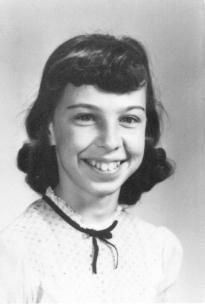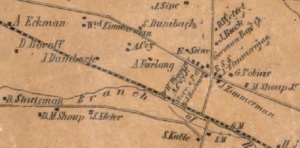Beavercreek Heritage Trail
Displaying items by tag: Shoup
This is the location of an infamous Greene County murder by the previously mentioned Charles Justice.
On September 16, 1910, John Shoup heard a commotion in the chicken house and sent William Shoup into the far end to flush out what he thought was a fox. They encountered a man whose description resembled Justice trying to steal their livestock. The thief fired three shots, one which killed John Shoup. According to testimony at the trial, Justice calmly picked up the bag of chickens and walked away. After many hours they finally caught up with him. Everybody was out looking. He was convicted of first degree murder on November 3, 1910 in the Greene County Court of Common Pleas.
Several hours before his scheduled execution, a long knife was found in Justice’s cell. He stated that he intended to use it on the guard who strapped him into the electric chair. Two other prisoners who were housed with him asked to be moved because they feared that he would kill them as well. His last words were “I am not guilty of the crime for which you are killing me.” Charles Justice was executed at 12:05 AM on October 27, 1911, the 38th person executed by the State of Ohio. No friends or relatives claimed his body and it was given to a medical school in Columbus.
An urban legend exists that the man who invented the electric chair was executed in it. This was attributed to Charles Justice. He was, in fact, incarcerated at the Ohio Penitentiary when “Old Sparky” was built to serve as a more humane form of execution than the gallows. A scrapbook entitled, “The Electrocution Book” was donated to the Ohio Historical Society in 1983 that was compiled by employees of the state’s prison system. In an undated article within called “The Electric Chair”, Richard J. Jemison states that a prisoner named Charles Justice helped build the chair and was later executed in it. Historical accounts state that Charles did not build the electric chair, but he was executed in it. Additional research suggests that while working in the prison’s tin shop, he fabricated metal clamps that replaced the leather straps for better performance. Charles is buried in Mount Calvary Cemetery in Columbus, Ohio.
The approaching curve was the location of the Shoemake Dairy Farm. Concrete remnants of the feed house can be seen on the north side of the curve and in the autumn/winter, you can find a silo hidden in the trees.
 Charles Justice Out Of Luck
Charles Justice Out Of Luck
Charles Justice Out Of Luck
Charles Justice Out Of Luck
 Shoemake Dairy
Shoemake Dairy
Shoemake Dairy
Shoemake Dairy
 Headstone of John Shoup
Headstone of John Shoup
Headstone of John Shoup
Headstone of John Shoup
 Erroneous News Article
Erroneous News Article
Erroneous News Article
Erroneous News Article
 News Clipping 2
News Clipping 2
News Clipping 2
News Clipping 2
 News Clipping 3
News Clipping 3
News Clipping 3
News Clipping 3
 Old Sparky
Old Sparky
Old Sparky
Old Sparky
https://www.beavercreekliving.com/community/history/itemlist/tag/Shoup#sigProIdaadbfa129e
The home at 619 N. Fairfield Road dates to 1896 and was built for C. Coy.
After cresting the hill heading south on North Fairfield Road, you‘ll find the farms of Daniel and Moses Shoup on the west. Just beyond Fairbrook Elementary school is the Shoup-Durnbaugh House located at 182 North Fairfield Road. Originally built by Moses Shoup, a prominent farmer and 50-year German Baptist minister, in 1820.
Later it became known by another locally famous owner, son-in-law Benjamin F. Darst. Benjamin served as a Lieutenant and Captain in the Civil War. Son of Benjamin and Rebecca (Shoup), Harry was a prominent local banker who entertained graciously in the house until his death in 1962. The home has been lovingly restored by John & Brenda Durnbaugh since their purchase in 1982.
https://www.beavercreekliving.com/community/history/itemlist/tag/Shoup#sigProIde88f5f1d55
Turn right onto Patterson Road. Both homes at 3927 and 3928 E. Patterson Road date to c.1900 and were on Shoup land. On the right at 3827 E. Patterson Road is the Daniel Shoup House. This Vernacular style all-brick home was started in 1857 by Solomon Shoup and completed by his son Daniel in 1858.
The home and 200 acres were assumed later by Arthur Shoup, Daniel’s son, who was a progressive farmer for his day; incorporating crop rotation. He was the first dairy farmer in the area to employ an automatic milking machine. Unlike his father and grandfather, he did not pursue the tradition of being a minister in the German Reformed (Dunkard) Church.
 Tragedy struck this very spot on November 2, 1959 when an F-104 Starfighter lost power and crashed into the former schoolhouse that had become the residence of Grace Shoup and her family. Grace, who ran from the home with her clothing afire, later died from her injuries. Daughters Lynn and Lora were killed in the crash. Ten year old Billy and eight year old Tommy Shoup were at school and learned of the devastation to their family as news spread through the community.
Tragedy struck this very spot on November 2, 1959 when an F-104 Starfighter lost power and crashed into the former schoolhouse that had become the residence of Grace Shoup and her family. Grace, who ran from the home with her clothing afire, later died from her injuries. Daughters Lynn and Lora were killed in the crash. Ten year old Billy and eight year old Tommy Shoup were at school and learned of the devastation to their family as news spread through the community.
Tom Shoup graduated from BHS in 1969, his father owned Shoup Sporting Goods in the Knollwood area. A recollection has been shared of the tail section of the plane sitting in the middle of the burned wreckage that used to be the home.
 The Journal Herald Article #1
The Journal Herald Article #1
The Journal Herald Article #1
The Journal Herald Article #1
 The Journal Herald Article #2
The Journal Herald Article #2
The Journal Herald Article #2
The Journal Herald Article #2
 Tragedy
Tragedy
Tragedy
Tragedy
 Grace Shoup
Grace Shoup
Grace Shoup
Grace Shoup
 F-104 Starfighter Stock Image
F-104 Starfighter Stock Image
F-104 Starfighter Stock Image
F-104 Starfighter Stock Image
https://www.beavercreekliving.com/community/history/itemlist/tag/Shoup#sigProId575aad4a19
Editted Text of the November 3, 1959 Journal Herald article:
'A jet Starfighter crashed broadside into a house near here today and buried itself in the ruins. Two young sisters were killed. The pilot ejected to safety. The mother of the girls, Mrs Grace Shoup 37, ran from the house her clothing in flames after the supersonic craft crushed the house and exploded. She is in critical condition. The sisters were Lynn Shoup 12 and Laura 2. Their brothers, Billy 10 and Tommy 8, were in school. Lynn a was to have reported for her half-day session of school at noon. Their father was at work.
Wallace McCormick 27, was driving past the house when the plane hit. Flames from the blast shot clear across the road more than 50 feet away and enveloped my car, he told newsmen. The fire was all over the car could feel the heat. I lost control and hit the ditch about 50 yards down the road. When I got a look at the house it was a complete wreck and Mrs Shoup was running cross the yard with her clothing afire. McCormick was uninjured. Shaken neighbors beat out the flames and hustled the screaming woman to a hospital. The pilot, Maj James W Bradbury 34, ejected at low altitude when his craft lost power on takeoff. The house, a converted brick school building, is located about eight miles south of Air Force Base where Major Bradbury is based. Major Bradbury is one of the few men to survive ejection from a Starfighter one Air Force source said.
The Little Beaver Creek parallels on the south side of the bypass and crosses to the north side just west of the I-675 underpass. In the 1870’s this area was owned by John Coy on the west and Daniel Shoup on the east.
This section of road roughly follows the former route of the Baltimore & Ohio (B&O) railway. This was a narrower gauge rail, meaning the tracks were closer together. Nearby were the tracks that accommodated the Dayton and Xenia Traction line, the second generation of trolley cars that ran from Xenia into Preble County as well as from Dayton to Troy and Springfield.
 Area Growth
Area Growth
Area Growth
Area Growth
 B&O Railroad Medallion
B&O Railroad Medallion
B&O Railroad Medallion
B&O Railroad Medallion
 John Coy
John Coy
John Coy
John Coy
 Jed's and the Mouse That Roared
Jed's and the Mouse That Roared
Jed's and the Mouse That Roared
Jed's and the Mouse That Roared
 Whiskey Train
Whiskey Train
Whiskey Train
Whiskey Train
https://www.beavercreekliving.com/community/history/itemlist/tag/Shoup#sigProId2413bf82e7
The German Baptist church was prevalent in Zimmerman and throughout the township dating back to 1805, the original ministers being Jacob Miller, Elder Sigler and Moses Shoup. Once a year, their custom of ‘washing of feet’ would occur following communion. One of the ministers would wash the feet of the brethren (the men), while the sisters would wash the feet of the ladies. In slang, they were often referred to as ‘Dunkers’ or ‘Dunkards’ due to their tradition of full immersion during baptism, where members kneeled into the water and were dipped three times, face first.
German Baptists were opposed to war and would not bear arms, nor vote at political elections. Disputes were settled in the church without appealing to the laws of the country.
Also in Zimmerman were a blacksmith shop and the Stewart Grocery, which would provide on credit or by barter. During the Great Depression, Crawford Smith owned the store, then named Smith Grocery, he offered credit to accommodate customer’s needs regardless of ability to pay at that time.
Latest Blog Posts
- Just Don't Call Us Late For Dinner...
- Remember When...
- What A Long, Strange Trip It's Been...
- Snow Down = Slow Down
- School Bus Safety - Just Do It!
- Stevenson Road Covered Bridge
- Our Road Crews Are Worth Their Salt!
- The Most Colorful Of Seasons!
- Popcorn Fest! - Then And Now
- Pre-School Paradise!
- Remembering Riffles
- Ten Year Anniversary Of The Beaver Statues










